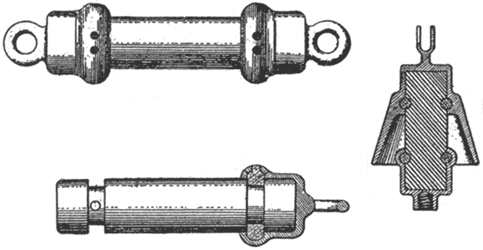[Trade Journal]
Publication: Western Electrician
Chicago, IL, United States
vol. 10, no. 3, p. 30, col. 1
Andrews' Insulators.
The body of these insulators consists of a rod or block of wood or other insulating material, having at each end a groove which preferably, though not necessarily, extends
 |
| Andrews' Insulators. |
entirely around the block. Fitting over the ends of the block are metal caps, having eyes to which wires may be connected. Each sleeve or cap is provided with a groove corresponding in position to the depression in the block, that is, the grooves are so placed on the block and on the cap, respectively, that when the parts are put together the grooves register with each other. Each cap is provided with one or more holes, which extend through the body to the groove.
In making the insulator the calps are slipped onto the plug of insulating material and melted type-metal is poured through the holes into the space formed by the grooves. When the metal cools, the caps and body will be rigidly secured together by the metal rings which are partly embedded in the caps and partly in the body and extend into the holes. By actual test an insulator, constructed by the inventor, W. S. Andrews, of New York, as above described, in which the body was one inch and a half in diameter and in which the metal rings were about three-eighths of an inch square, broke only at a strain of four thousand pounds.
